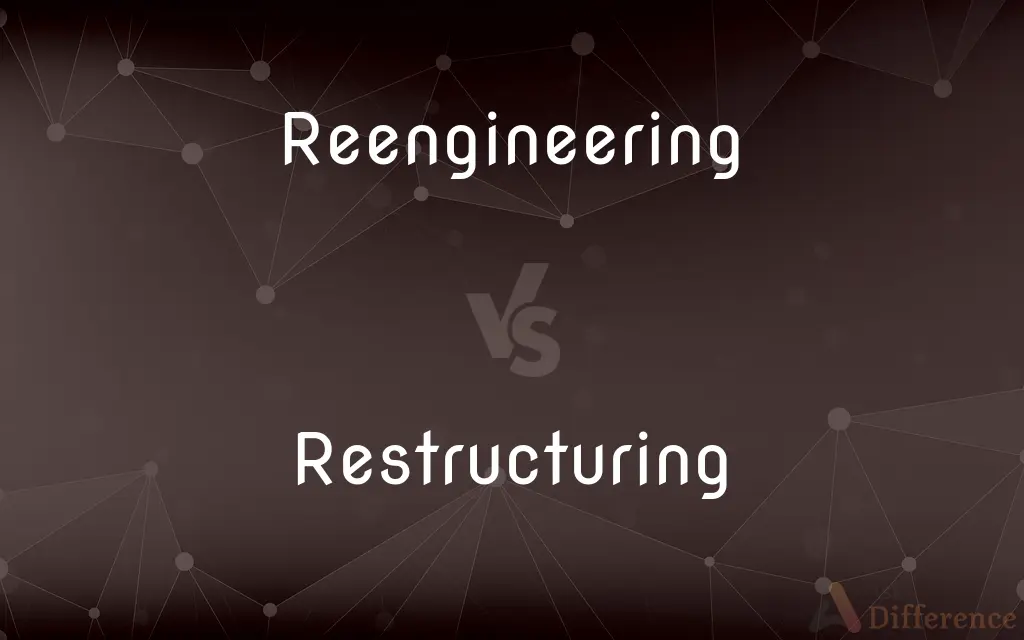Reengineering vs. Restructuring — What's the Difference?
By Fiza Rafique & Maham Liaqat — Updated on March 11, 2024
Reengineering focuses on redesigning business processes for efficiency, while restructuring involves changing organizational structure to improve operations.

Difference Between Reengineering and Restructuring
Table of Contents
ADVERTISEMENT
Key Differences
Reengineering and restructuring are strategic approaches businesses use to improve efficiency, competitiveness, and overall performance, but they differ fundamentally in their focus and execution. Restructuring, on the other hand, typically involves changing the organizational structure of a company.
Reengineering might require a deep dive into the processes that are the backbone of a business, looking for ways to completely revamp or eliminate inefficient steps. Restructuring, while it can also lead to significant changes within an organization, tends to have a different focus.
Both reengineering and restructuring can be disruptive and challenging to implement, requiring strong leadership and a clear vision for the future of the organization. While reengineering often focuses on long-term strategic benefits derived from fundamentally rethinking how work is done, restructuring might be driven by immediate financial pressures or a need to respond quickly to changes in the market or industry.
The choice between reengineering and restructuring depends on the specific challenges and opportunities facing a business. Reengineering might be the preferred strategy when the primary issues relate to inefficient processes that are holding back performance. In contrast, restructuring may be more appropriate when the problems are more about organizational inefficiencies, poor alignment of resources, or structural impediments to agility and responsiveness.
Comparison Chart
Focus
Business processes
Organizational structure
ADVERTISEMENT
Goal
Improve efficiency and effectiveness of processes
Improve operational efficiency by altering structure
Approach
Radical redesign of core processes
Redistributing responsibilities, consolidating departments
Emphasis
Process innovation and optimization
Organizational and financial optimization
Outcome
Significant improvements in cost, quality, service, and speed
More efficient organizational structure
Compare with Definitions
Reengineering
The radical redesign of business processes to achieve dramatic improvements.
A company reengineered its customer service process, reducing response time from 24 hours to 1 hour.
Restructuring
Modifying the organizational structure to streamline operations.
After restructuring, the company reduced its management layers, enhancing decision-making speed.
Reengineering
Emphasizes creativity and innovation in processes.
The firm reengineered its manufacturing process, integrating AI to enhance production efficiency.
Restructuring
Aims to enhance efficiency by altering the hierarchy and departmental organization.
The company's restructuring led to the merger of two departments, eliminating duplication of efforts.
Reengineering
Often involves starting from scratch.
The company reengineered its product development process, significantly shortening time to market.
Restructuring
Seeks to better align resources with business goals.
The restructuring included a workforce reduction to align with the company's revised strategic focus.
Reengineering
Centers on optimizing the way work is done.
Reengineering the order fulfillment process eliminated unnecessary steps and doubled throughput.
Restructuring
Focuses on improving financial health through structural changes.
The restructuring plan included divesting unprofitable divisions to focus on core business areas.
Reengineering
Seeks significant, not incremental, improvements.
By reengineering its supply chain, the company cut logistics costs by 50%.
Restructuring
Often driven by immediate financial or market pressures.
Facing declining sales, the company underwent restructuring to cut costs and improve competitiveness.
Reengineering
Present participle of reengineer
Restructuring
Restructuring is the corporate management term for the act of reorganizing the legal, ownership, operational, or other structures of a company for the purpose of making it more profitable, or better organized for its present needs. Other reasons for restructuring include a change of ownership or ownership structure, demerger, or a response to a crisis or major change in the business such as bankruptcy, repositioning, or buyout.
Reengineering
The application of technology and management science to the modification of existing systems, organizations, processes and products in order to make them more effective, efficient and responsive.
Restructuring
To alter the makeup or pattern of
"serious efforts to restructure third world debt" (Felix Rohatyn).
Restructuring
To make a basic change in (an organization or a system, for example).
Restructuring
To alter the structure of something.
Restructuring
Present participle of restructure
Restructuring
A reorganization; an alteration of structure.
Common Curiosities
What is reengineering?
Reengineering is the fundamental rethinking and radical redesign of business processes to achieve dramatic improvements in critical measures of performance.
Can a company undergo both reengineering and restructuring?
Yes, a company may undergo both to address different aspects of its operations and structure for overall improvement.
How does reengineering differ from restructuring?
Reengineering focuses on redesigning processes for efficiency, while restructuring involves changes in organizational structure to improve operations.
Why do companies reengineer their processes?
To achieve significant improvements in cost, quality, service, and speed by innovating and optimizing their core processes.
What are the risks of reengineering?
It can be disruptive, requiring significant changes that may face resistance, and its success depends on effective implementation.
What is the role of leadership in reengineering and restructuring?
Strong leadership is crucial for both, to provide vision, direction, and to manage change effectively.
How long does restructuring typically take?
The time frame can vary widely depending on the scope and scale of the restructuring efforts.
What is restructuring?
Restructuring involves changing the organizational structure of a company to improve efficiency and effectiveness.
Why might a company choose to restructure?
To align its organizational structure more closely with its strategic goals, streamline operations, and reduce costs.
What is the first step in a restructuring process?
Typically, it begins with a thorough analysis of the organization's current structure, performance, and strategic goals.
What are the risks of restructuring?
Restructuring can lead to morale issues, loss of key personnel, and the potential disruption of day-to-day operations.
Is reengineering more about technology or processes?
While technology can play a role, reengineering primarily focuses on processes and how work is fundamentally done.
How do companies identify processes for reengineering?
Through analysis of performance metrics, customer feedback, and benchmarking against best practices.
Can reengineering improve customer satisfaction?
Yes, by optimizing processes, companies can improve quality, speed, and service, enhancing customer satisfaction.
Can restructuring lead to layoffs?
Yes, restructuring often involves downsizing or reallocation of resources, which can result in layoffs.
Share Your Discovery

Previous Comparison
Eager vs. Impatient
Next Comparison
Interstate vs. TurnpikeAuthor Spotlight
Written by
Fiza RafiqueFiza Rafique is a skilled content writer at AskDifference.com, where she meticulously refines and enhances written pieces. Drawing from her vast editorial expertise, Fiza ensures clarity, accuracy, and precision in every article. Passionate about language, she continually seeks to elevate the quality of content for readers worldwide.
Co-written by
Maham Liaqat













































